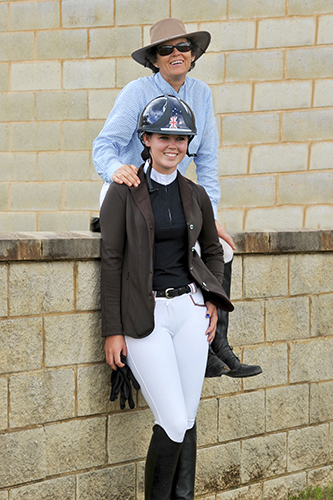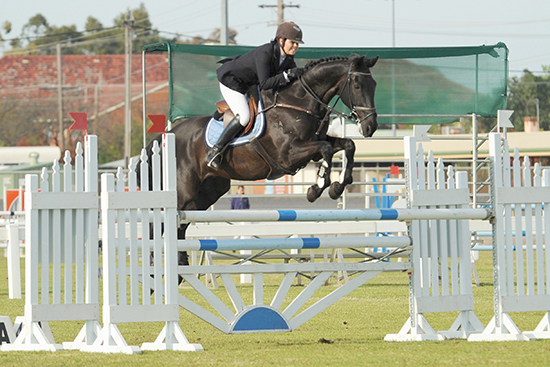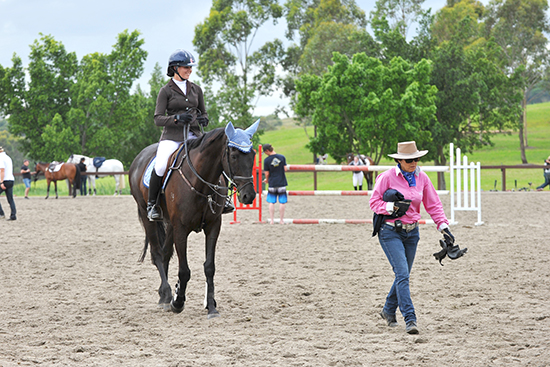 Words: Alexandra Bruggisser Photos: Roz Neave & Rachel Smith/Furdography
Words: Alexandra Bruggisser Photos: Roz Neave & Rachel Smith/Furdography
Colleen Brook has represented Australia in showjumping at various corners of the world, and in my opinion, her contribution to the sport as a rider, trainer and teacher is enormous. Colleen runs her own CJB Training Stables from the horsey Hawkesbury area in New South Wales, she’s the riders’ representative on the National showjumping committee, an NCAS Level 3 coach and coach educator, plus mum/coach/driver/groom etc of up-and-coming young rider, Liz Koob.
“Think about what you do on landing. Keep your body up, get back in position, get your legs back and be ready for the next jump… Yeah, pretty good. Next time just bring him more together. Right, turn shorter, don’t go too wide, just a little bit shorter and more together. Take your time, remember outside you need to get a couple of closer ones, that’s better. Yeah there you go. Keep it short, keep it short, good job.” Liz’s steed, Queen’s Crusader (stable name, Bolton), is a kind, unremarkable black Thoroughbred gelding. He looks placid, seems happy and tries hard for his rider. He’s not as talented at sitting on his hindquarters as some of the other imports trotting around the warm-up arena, but his heart is in it.
Having been in similar positions, with Mum helping in the final warm-up at a big show, I am impressed at how amicable the whole affair is. Liz looks cool and calm, Colleen appears to be much the same and then… “Ok so in she goes to the ring. She warmed up pretty well, fairly relaxed and as calm as you could be for a final. As a parent you hope they go well and they’re safe and don’t make too many boobs and then as a coach you just hope they don’t… Oh crikey! We’re ok, that was fence two. I think I’m hyperventilating just watching here. Oh gosh this is hard! Come on old fellow.”
Liz heads into the double and there’s an unexpected “GET UP!!” of encouragement from under her flash, new, Antarés helmet. Colleen is a bit taken aback at her daughter’s surprise growl, “Oh, easy. Click, click. Yeah you’re going alright, good. Don’t know what he needed that one for. Oh he’s an old bugger (one rail down), right in front of the thingos (VIP tents) too. Could have jumped them really. Yes, got there too close (another rail down). Whoooaa. Take your time Liz, take your time (through the treble)! Straight, good job! Oh well, four down was it? Righto.”
Liz joins us from the ring, there’s a quick visit to the boot weigh-in tent, an announcement that she’s ended up with two time faults and then a summation of events from the coach, “Well, it seems time is tight! She ended up with two down in front of the VIP tents and then he got up too close to fence 8. Then 9 was alright but the middle part of the treble we had down and two time. Which means you have to gallop pretty damn fast and when you’re early out it’s hard to know, sounded like ended up with 18 penalties, two time and four down.”
As we watch the next several riders going around I ask Liz to give us a bit of a debrief of how the round was from her boots, “Well, some parts got a bit messy. In general it was alright. I got a bit deep to 3a and had to shout a bit to get him over the second… Ah, someone else is struggling through the treble. That makes me feel a little bit better.”
Colleen puts things in perspective for her daughter before asking for further analysis, “There have been two eliminations so far and the winner is on 12 penalties. I was a bit surprised you had two time penalties. You were going forward, I don’t know how that happened… But the time is obviously quite tight and that is the risk that you take being on early and not quite knowing how the course is riding. We only just qualified for the final, and first and second out is always tough. It was a bit messy in places and what else?”
“I felt like I should’ve stayed a bit straighter.”
“Straightness, YES! Straightness on landing. Because I felt that when we walked the course the lines were broken lines. You had to be straight on landing and then get your curve. The course was a good test, that treble takes some jumping!”
I’ve never seen quite such a harmonious parent/offspring coaching relationship. We’ve all seen the ugly ones! Liz’s take on the whole matter, “As a coach Mum is great because she knows me and my horses so well she knows exactly what’s going on and exactly what exercises we should be doing. I am constantly learning around her. Usually in lessons on Bolton, we focus on accurate corners, straight lines and me keeping my eyes up, regaining balance after the fence and a few fun things like narrow obstacles and water. Nothing beats the basics. In warm-ups, the horse is very brave and scopey so the jumps are not a problem. For me, Mum says I seem to have a good grasp on what I need to do to for myself to be prepared and we work it out together.”
Colleen Brook is a multi-talented woman with many hats! Remember: Experience is a great teacher.
Colleen’s tips when it comes to an effective warm-up at a show:
• The hardest part of warming up is knowing just how much you need to work your horse before the competition. To improve your warm-up and the time you spend at the practice fence you’ve got to tailor the program to suit horse and rider.
• I always try to give myself the maximum time allotted in the practice area. Although if you or your horse suffer from pre-competition nerves I’d suggest you get on your horse early and cruise around the whole complex.
• Some horses do not cope with all the activity in the practice area. If they are over-the-top, keep calm and re-adjust your expectations. Stick to the basics; your pace, your line. If you get aggressive with horses, they become anxious and worried. So be prepared for a little patience and don’t stress.
• Make a warm up plan with a couple of ‘what if’ options. Approx 10 jumps should make you ready to go in and jump the course.
• If your horse is a zippy type keep the fences down a bit and make sure you have a minute to allow the adrenalin to seep out and collect yourself mentally before you go into the arena. The lazier types need to go over one last jump, then straight into the ring.
• The height depends on your standard, too big makes the horse back off too much, whereas too small is not enough to open them up. This is where you need to watch better riders at another time, not when you are warming up yourself, to see what their routine is.
• Some riders warm every horse up the same because that is the best way for them to get into the ring prepared. Other riders are very tuned into the individual horse, but try to be adaptable, try and feel what your horse is telling you.
• The more starts the horse will have at the show, the less jumps you need in the warm-up. The ground is also a factor; deep ground should mean you do less jumps and keep them smaller, hard ground is the same, on good ground, breathe easy and enjoy the jumps.
• In terms of type of jumps; small oxers and rising oxers are best and you should finish with a vertical. Always try to have ground lines.
Want more articles from Colleen? Go to her Who’s Who and you will find a directory…


